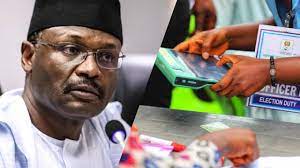By Ibukun Phillips
Transparency and accountability are two of the main features that have characterised the Independent National Electoral Commission since Prof Mahmood Yakubu assumed office as the Chairman of the commission in 2015.
The commission has been open in its dealings, dwarfing the myth of secrecy in Nigeria’s electoral process.
The Commission under his leadership also introduced and enhanced processes that promote transparency, integrity and credibility of the electoral process, an action that has earned both INEC and its chairman national and international accolades and awards.
The recently published 526-page document titled, ‘The Report of 2023 General Election’ on the conduct of the 2023 election, especially the aspect that detailed the glitch experienced in the uploading of the Presidential Election Result, is a testament to the integrity of the commission.
Not many agencies and organisations in Africa are known to admit glitches, not to talk of detailing it as much as INEC did in the report. It was a bold move considering that the failure to upload the presidential election result was the only dent on the otherwise peaceful and orderly exercise nationwide.
It was a key challenge that impacted on the public perception of the election and elicited widespread commentary is the failure to upload Polling Unit results of the presidential election to the INEC Result Viewing (IReV) portal in real-time at the close of polls on Saturday February 25, 2023.
It is imperative to know that the IReV portal, which is one of the most significant innovations introduced by the Commission prior to the 2023 General Election to promote the integrity and transparency of the electoral process, was a public-facing website, showing the images of the original Polling Unit result sheets as recorded in Form EC8A.
So, the glitch has no effect on the integrity and credibility of the poll because agents of political parties and security agencies were given copies of the polling unit results after they were announced in public. The results were also displayed at polling units for scrutiny by voters. Therefore, when they were eventually uploaded, it was easy to compare them with the copies displayed at polling units and given to the party agents and party officials.
According to the Commission, the operational methodology and the concept behind the upload of results to the IReV for public viewing is quite simple. At the end of polls, Polling Unit results (Form EC8As) are scanned and uploaded to the IReV by the Presiding Officer(s).
These results are then available for viewing to the public and all stakeholders. The system, which was first deployed during Nasarawa Central State Constituency bye-election in August 2020 and tested in 105 subsequent elections, including three off-cycle governorship elections, has tremendously improved public confidence in the integrity and transparency of the Commission’s result management process.
“The challenge of uploading the PU presidential election results on the IReV after the presidential and NASS elections on 25th February 2023 was unique. As voting ended across the country and POs began the process of uploading the images of the PU result sheets of the elections for the various constituencies around 4:00pm, the Commission began to receive reports that attempts to upload presidential election result sheets was failing. Following these reports, the Commission immediately engaged with its field officials for details in order to understand, and trace the origin, source, scale and magnitude of the problem across the result management ecosystem to devise appropriate solutions,” noted a part of the report.
INEC said that in the troubleshooting process, it was established that there was no issue in uploading the PU result sheets of the Senate and House of Representatives elections through the Election Result Modules. However, there was a problem with uploading the presidential election results to the system. Attempts to upload the results were generating internal server errors, which refer to a significant impairment that usually originates from within an application due to problems relating to configuration, permissions, or failure to create or access application resources correctly. Further interrogation of the Election Result Modules indicated that the system is encountering an unexpected configuration problem in mapping the presidential election results uploaded into the system to the participating Polling Units.
“Due to the complex, sensitive and critical nature of the systems and the real potential for malicious cyberattacks, the Commission immediately put in place several strict security and audit control measures to prevent any unfettered or elevated access to the Result Upload System. In the process of resolving the challenge, it was discovered that the backend system of the IReV was able to query and detect the base States for uploading the PU result sheets based on the mapping of all Senatorial District and Federal Constituency elections to the respective 36 States of the Federation and the FCT as established in the database structure deployed within the system. In configuring and mapping the election results for the presidential and NASS elections, the Commission created Four Hundred and Seventy (470) election types consisting of one presidential constituency covering the entire country, 109 Senatorial Districts and 360 Federal Constituencies. Each Senatorial District and Federal Constituency election on the database was mapped to their respective States. However, the presidential election result is a single, countrywide constituency and therefore, does not belong to any one State.
“Consequently, while the uploads for the NASS elections succeeded as the application was able to identify the respective State and build the folder hierarchy for the results organization process for the election, attempts to upload the presidential election results sheets, which does not belong to or mapped to any State on the database, failed. Instead, it returned a HTTP server error response. This failure is attributable to the inability of the application to create and build a folder structure to organize the uploaded images of the result sheets of the presidential election,” it said.
With my over two decades experience in the digital space, I can attest that it is not unusual to encounter this type of challenge. Despite best efforts, it is not unusual to experience technical glitches in the deployment of technologies, the most important is the ability to trace and fix them as soon as possible. And this, INEC did successfully without allowing any tampering with the outcome of the exercise.
The report added that having identified and established the source of the problem, the electoral commission quickly created and deployed “Hotfixes” which are software updates for fixing a bug or any vulnerabilities in a system. The deployed hotfixes eventually resolved the HTTP error on the system and the first presidential election result sheet was successfully uploaded at 8.55pm on the 25th of February 2023.
“After the problem with the upload was resolved, the Commission noticed a high volume of uploads on the queue. All results that scanned but could not be uploaded due to the error were queued waiting to be automatically processed. Due to the large volume and high traffic from the queue, the system was running slower, even though it tried to scale up automatically to handle the unanticipated heavy traffic. The density of the traffic that slowed the uploads was one issue. Another was that the offline queue requires the BVAS devices to be switched-on and connected to the internet for the upload. However, some of the POs had at the time left their PUs, and the devices had either been switched-off, or were out of internet coverage. Switched-off devices could not connect and upload the results sheets. The Commission had to reach out to the POs of affected areas to switch-on their systems and ensure internet connectivity for the uploads to continue. This accounted for the delay, with some of the results coming in the next day,” it said.
It is gladdening to note that the glitch didn’t affect the integrity of the poll because of the ‘foolproof’ process supervised by INEC. The release of the report and the detailed explanation of the glitch experienced in uploading the Presidential Election Result will be helpful in future elections as well as serve as a guide to other electoral bodies all over the world, especially in Africa where INEC has demonstrated unmatched integrity and leadership.
Philips writes from Lagos





